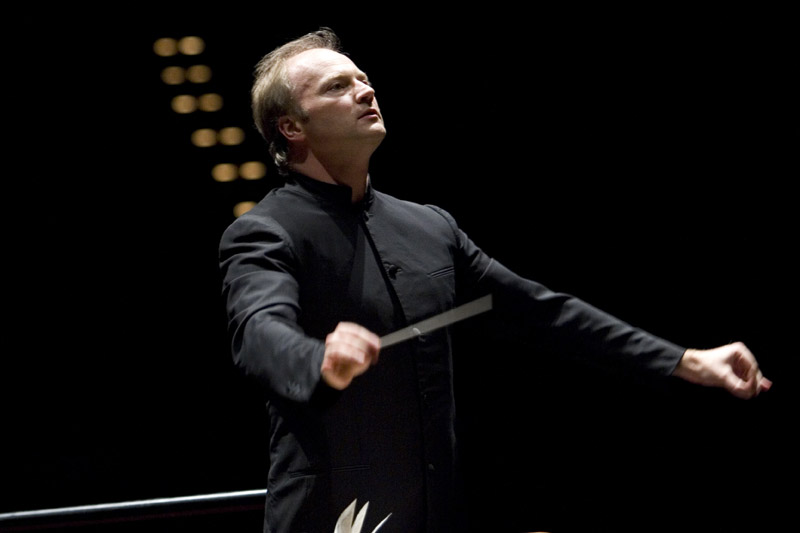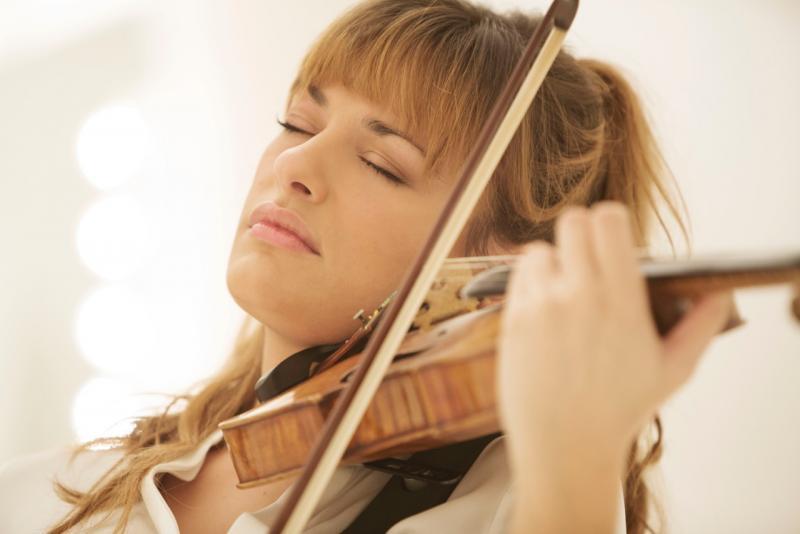Shostakovich is ideal for Nicola Benedetti. His music requires effortless and understated virtuosity, as well as a confident and commanding maturity of interpretation. Benedetti has been demonstrating these qualities since her late teens, and all were evident in this reading of the First Violin Concerto, which proved an intense and compelling listening experience.
In the opening Nocturne, Benedetti dug heavily into the strings, bringing an intense physicality to her tone. Sometimes she pushed too hard, leading to voicing issues and jarring breaks. But that intensity continued, even as Benedetti relaxed her bow arm to bring a rounder warmth to the tone. The arching structure of this first movement was elegantly described in Benedetti’s broad phasing, creating a single line of melody, gradually growing in intensity, and never losing focus or concentration.
From the second movement, it was clear that conductor Gianandrea Noseda (pictured below) was on the violinist’s wavelength, drawing similar intensity from the orchestra. The playing here was positively lurid, with Benedetti taking a lead from the frenetic tuned percussion in each of the maniacal dance episodes. Noseda also tried to open the Passacaglia third movement with similar weight, but some poor ensemble in the first statements of the bass theme meant that the dark mood took a little longer to establish. But it was firmly in place when Benedetti entered, initially seeming to support her high cantilena lines, but gradually taking on a more sinister and oppressive edge as the solo line turned lonely and introspective.
The cadenza introduction to the finale felt like a brief moment of release, though even here Shostakovich’s demons are never far from the surface, given voice in Benedetti’s dark-toned virtuosity. In the finale, the orchestra grows in confidence and weight, vying with the soloist for the spotlight. Noseda again drew bold and dynamic energy, especially from the woodwind soloists, but Benedetti held her ground, her virtuoso roulades dominating the coda, even across the incisive rhythms of the full orchestra.  After many years under Valery Gergiev, the London Symphony is now a well-oiled machine for Shostakovich symphonies, so Gianandrea Noseda could be forgiven for deferring to their expertise. But that’s not his way, and his Tenth Symphony was characterised by a very different approach to phrasing. At the opening, for example, the short phrases that make up the main theme in the low strings were distinct, all separated by clear silences. Yet his approach to the overall structure was as unified and coherent as Benedetti’s in the concerto. As the dynamics grew, he was always in control of the emotional temperature, the build-up not just a simple crescendo, but a complex interaction of constraint and release. The sheer weight of the LSO’s string sound is a huge asset in Shostakovich, and Noseda knows how to marshal it. In the first movement, a warm bed of sonorous strings supported a series of woodwind solos, beginning with the clarinet. But each soloist contrasts the stability of that string sound with a sense of fragility; the authoritarian mass against the vulnerable individual.
After many years under Valery Gergiev, the London Symphony is now a well-oiled machine for Shostakovich symphonies, so Gianandrea Noseda could be forgiven for deferring to their expertise. But that’s not his way, and his Tenth Symphony was characterised by a very different approach to phrasing. At the opening, for example, the short phrases that make up the main theme in the low strings were distinct, all separated by clear silences. Yet his approach to the overall structure was as unified and coherent as Benedetti’s in the concerto. As the dynamics grew, he was always in control of the emotional temperature, the build-up not just a simple crescendo, but a complex interaction of constraint and release. The sheer weight of the LSO’s string sound is a huge asset in Shostakovich, and Noseda knows how to marshal it. In the first movement, a warm bed of sonorous strings supported a series of woodwind solos, beginning with the clarinet. But each soloist contrasts the stability of that string sound with a sense of fragility; the authoritarian mass against the vulnerable individual.
The emphatic down-bow unison rhythms in the second movement were genuinely terrifying, this another dimension of the LSO’s string sound perfectly suited to Shostakovich. Noseda drove these tuttis with a manic energy of his own, each note hammered out as a downbeat from both arms, the rest of his body shaking from the intensity of the action. He can maintain this for minutes on end, for the climaxes of both the outer movements and for the whole of the Scherzo. It looks exhausting, but it energises the players and maintains the intensity.
The third and fourth movements are characterised by a reflective passages from the solo woodwinds, often leading into further frenetic climaxes. Again in the third movement, and especially in the opening of the fourth, the soloists gave that feeling of fragility and isolation in the face of the orchestra’s potential violence, a psychological effect given all the more power by Noseda’s ability to make the orchestral outburst unpredictable, looming crescendos either interrupted, or wholly illusory. That’s as much a theatrical effect as musical, and Noseda has the intuitive sense of drama to bring it off. Just one of the many qualities he brings to make the Noseda/LSO combination a near-perfect fit for Shostakovich.
- The performance of Shostakovich’s Tenth Symphony from this concert can be watched online at: https://www.youtube.com/watch?v=fXUIbQWdXhc
- Nicola Benedetti will perform Shostakovich’s First Violin Concerto with the City of Birmingham Symphony Orchestra on 27 and 28 June. For more information, please visit: https://cbso.co.uk/event/nicola-benedetti-shostakovich














Add comment